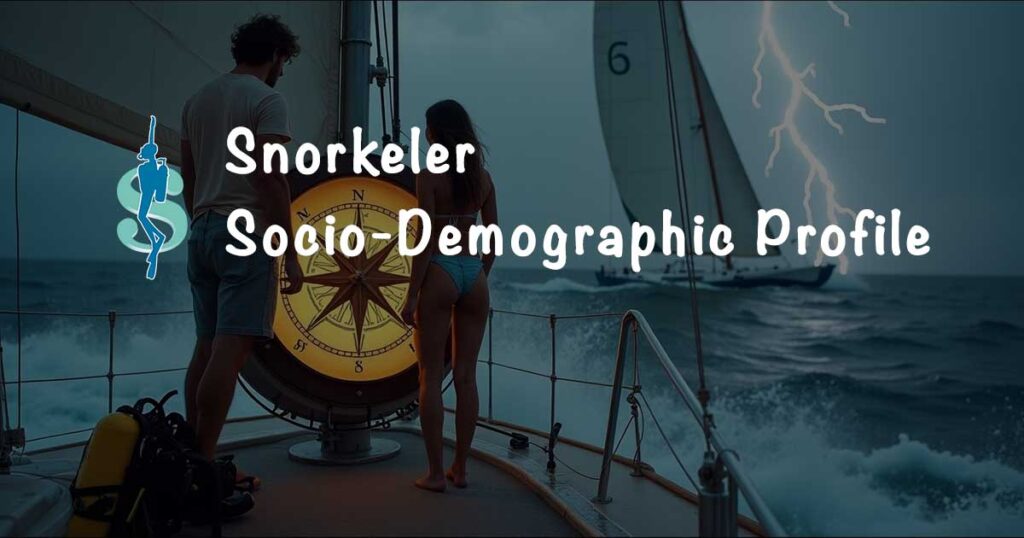Socio-Demographic Profile of a Snorkeler & Snorkeling Participation Rate
Who are the snorkelers? How do they differ from scuba divers? Why aren’t they scuba diving?
Snorkeling and scuba diving seem like two members of the same family — a brother and a sister, maybe. In both cases, the activity is practiced by people drawn to the underwater world, who can swim and are not intimidated by jumping into the ocean to discover the rest of their planet.
Numerous dive charter boats supplement their income by organizing snorkeling outings. Meanwhile, local dive shops in urban areas often derive a significant portion of their profitability from sales of masks, fins, and snorkels to non-scuba divers.
Yet, we allocate very little time to thinking about snorkeling and snorkelers.
This post is part of our Dive Industry Compass series by the Business of Diving Institute and Darcy Kieran, author of:
Contents on This Page
TL;DR Overview
For scuba diving industry professionals, understanding the snorkeling market presents a significant, yet often overlooked, opportunity. The number of snorkeling participants in the USA is more than double that of scuba diving (7.5 million vs. 3.1 million in 2023), with an estimated 24 million active snorkelers worldwide compared to 8.6 million active scuba divers.
Like scuba divers, snorkelers are generally affluent and well-educated, with 52% earning over US$100,000 annually and 55% holding college degrees.
Snorkeling is also less male-dominated than scuba diving, with 52% male participation compared to 62% in scuba diving. Interestingly, the highest participation rate for snorkeling is among 13-17 year olds, contrasting with scuba diving’s peak in the 25-34 age group, suggesting that younger individuals may be more hesitant about the complexities of scuba diving.
The “stereotype” of a snorkeler is an Asian American male teenager with wealthy, educated parents. Despite this large market, participation in snorkeling is currently declining.
A crucial finding for dive shop owners and instructors is that snorkeling is often treated as a “sideline” or “afterthought” within the dive industry, despite many dive charter boats and local shops relying on it for income and gear sales. This lack of dedicated focus is identified as a contributing factor to its decline.
Professionals should note that only 13.8% of snorkelers also engage in scuba diving, ranking it low among their other activities, suggesting that automatically assuming snorkelers will convert to scuba divers might be counterproductive.
To reverse the decline and develop snorkeling as a profitable business, the industry needs to “think snorkeling” and create experiences where snorkelers don’t feel like “second-class citizens” within a scuba operation. This includes exploring options like tankless diving (surface-supplied air systems) to bring snorkelers closer to the underwater world without the extensive certification requirements of scuba.
A key recommendation is to establish dedicated staff teams for snorkelers to explore new ways to cater to this distinct market. Cross-promotional opportunities also exist with other popular activities among snorkelers, such as walking, hiking, jogging, and bowling.
How many snorkelers are there?
When we analyzed the scuba diving participation rate, we compared it to snorkeling, based on survey data reported annually by the Sports & Fitness Industry Association (SFIA).
In the USA, the number of snorkeling participants is more than double (2.4) that of scuba diving. In 2023, 7.5 million Americans participated in snorkeling, while 3,1 million did so with scuba diving.
Since we estimate that there are approximately 8.6 million active scuba divers worldwide, we can similarly estimate that there are roughly 24 million active snorkelers. This does not include people purchasing fins, masks, and snorkels to fool around in their backyard pool.
Snorkeling Participation Rate: Core & Casual
In the SFIA snorkeling and scuba diving market studies, a casual participant is defined as somebody who’s done it up to 7 times per year, while the core participant is someone who’s done it 8 times or more.
All Snorkelers
Casual Snorkelers
Core Snorkelers
It is unfortunate to see that the participation rate of snorkeling is falling. We discuss causes and solutions in our strategic analysis of the dive industry.
What is the socio-demographic profile of a snorkeler?
The socio-demographic profile of a snorkeler is quite similar to that of a scuba diver, although there are significantly more women involved, based on SFIA’s annual report on snorkeling.
Wealth & Education Profile of Snorkelers
According to the SFIA survey, snorkeling is confirmed as an activity for wealthy and well-educated individuals, much like scuba diving.
- 52% of active snorkelers earn more than US$100K per year (49% for scuba divers)
- 55% of active snorkelers are at least college graduates (55% for scuba divers)
Gender Profile of Snorkelers
Snorkeling is a male-dominated activity, but not to the same extent as scuba diving.
- 52% of snorkelers are male.
This is a much less significant gender segmentation than what we see in scuba diving, where 62% of active divers are men.
Age Profile of Snorkelers
While about 2.4% of Americans went snorkeling at least once during the year, people aged between 13 and 17 had the highest participation rate (25 to 34 for scuba divers).
Snorkeling participation age in the USA by age group (in parentheses, the scuba participation rate for that age group):
- 6 to 12: 2.2% (0.6%)
- 13 to 17: 3.2% (1.1%)
- 18 to 24: 2.8% (1.2%)
- 25 to 34: 3.0% (1.3%)
- 35 to 44: 2.9% (1.2%)
- 45 to 54: 2.9% (0.8%)
- 55 to 64: 2.1% (0.5%)
- 65+: 1.0% (0.2%)
This observation is consistent with our assumption that younger and older people are more reticent about engaging in an overly complicated activity like scuba diving.
Race Profile of Snorkelers
While Hispanics and Asian-Americans have the highest participation rate in scuba diving, Caucasians are more active in snorkeling than Hispanics.
Snorkeling participation age in the USA by race (in parentheses, the scuba participation rate for that age group):
- Asian American: 2.9% (0.9%)
- Caucasian: 2.6% (0.8%)
- Hispanic: 2.4% (1.0%)
- African American/Black: 1.0% (0.5%)
- Other: 4.5% (1.2%)
In other words, the “stereotype” of a snorkeler in the USA is an Asian American male teenager with wealthy, educated parents.
Cross Participation by Snorkelers in Other Activities
From the SFIA snorkeling report, we get the following list of the top 15 most popular “other activities” among active snorkelers. In parentheses is the popularity ranking this activity has with scuba divers.
- Walking for Fitness (2)
- Day Hiking (6)
- Treadmill (1)
- Free Weights: Dumbbells/Hand Weights (15)
- Bowling (3)
- Running/Jogging (5)
- Elliptical Motion/Cross-Trainer (8)
- Stationary Cycling: Recumbent/Upright (14)
- Swimming for Fitness (9)
- Bicycling: Road/Paved Surface (18)
- Weight/Resistance Machines (10)
- Camping: Within 1/4 Mile of Vehicle/Home (12)
- Fishing: Freshwater/Other (17)
- Kayaking: Recreational (20)
- Yoga (16)
This gives us an idea about where we could conduct cross-promotional marketing activities to recruit snorkeling clients. For instance, we could promote a bowling club in our dive shop while the bowling alley promotes our snorkeling activities.
Interestingly enough, only 13.8% of snorkelers also engage in scuba diving. It’s #36 on the list.
Why is snorkeling on the decline?
That’s a billion-dollar question.
Let me ask a different question: Who is taking care of snorkelers? What is the “snorkeling industry”? Right! Never heard of it!
Wherever snorkeling is offered as an activity, it’s usually a sideline — an afterthought to maximize the profitability of assets acquired for other purposes. Wherever snorkeling gear is sold, it’s a sideshow — whether in a sporting goods store or a dive shop.
Usually, snorkelers tag along with scuba divers and are handled by a scuba diving crew on a dive charter boat.
No business on this planet would grow if it remained a sideshow offered by people with little interest in it!
Step One of developing snorkeling as a growing and self-sustainable business is by “thinking snorkeling”. We need to help snorkelers gain access and enjoy their activity without making them feel like second-class citizens inside an overly complicated dive operation.
How can we further develop our business with snorkelers?
To develop snorkeling as a profitable business, we shouldn’t automatically assume that all of these snorkelers will become scuba divers. This could very well be another reason why snorkeling is on the decline — too much pressure to ditch snorkeling for scuba diving!
However, there may be ways to bring snorkelers closer to the underwater world, such as tankless diving. A surface-supplied air system allows people to get closer to the reef without adding cumbersome dive equipment, which is often used after extensive classes designed to boost dive training agencies’ profitability.
Our focus on the “self-contained” part of our beloved scuba diving activity may be one reason why we are not fully benefiting from a significantly larger market of people drawn to the underwater world but not interested in jumping through all the hula-hoops required to become a certified scuba diver.
Here’s an idea: Set up a team of staff members dedicated to snorkelers. Give them rope to experiment with new ways of satisfying that market. And let us know how it went.
What’s Next?
To manage a business in a fast-changing and highly competitive landscape, we need market data. We hope that one day, our dive industry association, DEMA, will begin working cooperatively with other parties, such as SFIA and OIA, to provide us with more actionable information. DEMA will never have the resources to produce the kind of market reports SFIA prepares every year. However, DEMA could co-sponsor additional survey questions to be collected along with the SFIA studies.
Video Summary & Thoughts
Have a look at more scuba diving market research, surveys, reports & statistics in Your Dive Industry Compass.
If the information in this post was valuable to you, would you consider buying me a coffee?
Either way, please help the dive industry by taking part in ongoing surveys. Results from our past scuba diving market studies are also available here.
Your Dive Industry Compass
Scuba Diving Market Research, Surveys, Reports & Statistics
Shifting Tides
Strategies for Today’s Scuba Divers
Living The Scuba Dream
Plan Your Scuba Instructor Career & Deep Dive the Plan
You may also be interested in The Immersion Zone (our podcast), Scubanomics (our newsletter for dive professionals), and our published books & reference guides.





